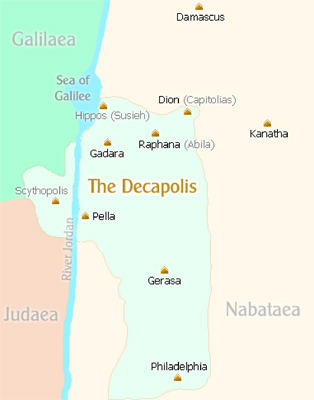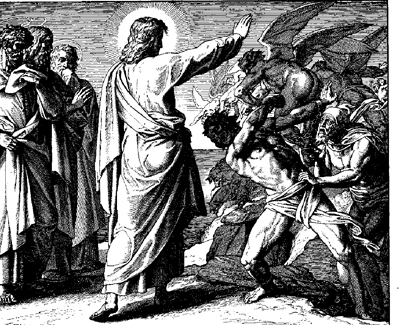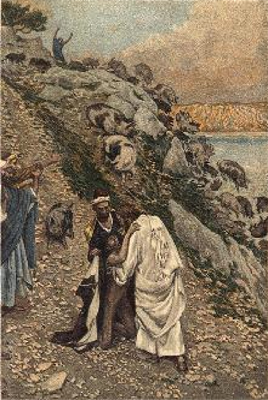
Christmas
Easter
Pentcoest
All Saints
Christ The King
Confirmation
Palm/Passion
Reformation
Stewardship
Books of the Bible
Lenten Series
Christmas Dramas
Videos
Series A - Matthew
Series B - Mark
Series C - Luke
Series D - Other
To contact
Edward F. Markquart
info@sfs.com

Series C PENTECOST 4C Luke 8:26-39 SYNOPSIS OF THE FOUR GOSPELS, Kurt Aland, English Edition, p. 78-80. This Bible study is from THE LIFE OF CHRIST: A Study in the Four Gospels. This free 54 week course for the laity will be available for congregations beginning in 2007. #91. Gadarene Demonicacs This is another great story in the Bible. Gardarenes or Gerasenes is a city which was located across the Sea of Galilee, directly opposite Capernaum, in the territory of the Decapolis. This territory of the Decapolis had ten Greek cities in it. In other words, it was in “Gentile” territory. It was located on the southeast shore of Lake Galilee. Context: We are studying a sequence of four stories:
We find this sequence of four stories in all three gospels, Mathew, Mark and Luke. These four stories belong together as a series. This story belongs with the previous story about Jesus calming the storms within nature; now Jesus calms the storms within a human being. Notice the parallels in the progression of the story in all three accounts:
In other words, there is a definite parallel progression of thought in Mark and Luke. In Matthew there are two demoniacs; in Mark and Luke there are one. We shouldn’t get hung up on the inconsequential details of the same story. The setting of the miracle: the Decapolis, a region of ten Greek cities. Locate the city of Gadara from which we get the name, “Garderene” demoniac.
http://www.atlastours.net/jordan/decapolis.html The following version of the story is primarily from the Gospel of Mark. -They came to the other side of the sea, to the country of the Gerasenes. Note that Matthew locates this countryside near Gadarenes. Find Gadara on the map above. Also find Gerasa on the map above. -And when he had stepped out of the boat, immediately a man out of the tombs with an unclean spirit met him. This disease was the first century equivalent of mental illness but with no modern drugs to control the mental illness. The unclean spirit was equivalent to demon possession. Notice the detail, “When Jesus had stepped out of the boat, immediately.” We remember Simon Peter was telling this story to John Mark before he, Peter, was crucified in Rome. In the Gospel of Mark and John, we are hearing reports from two eyewitnesses and both of them give us juicy little details. As a story teller, was Simon Peter giving us this detail in order to create the illusion of historical authenticity or was he reporting to us when he saw? I believe he was reporting to us what he saw. -He lived among the tombs; and no one could restrain him any more, even with a chain; for he had often been restrained with shackles and chains, but the chains he wrenched apart, and the shackles he broke in pieces; and no one had the strength to subdue him. Night and day among the tombs and on the mountains he was always howling and bruising himself with stones. I remember when I was a chaplain at Hastings State Mental Hospital in Hastings, Minnesota. One day, I visited the deep, darkened basement of one of the old dormitories and saw the chains fastened to the walls, above a cement floor. These chains were to restrain "mentally ill" people. There was a cement trench for human urine and feces. I was told that before the advent of modern drugs in the 1940s, the mental health professionals used to chain mentally insane people to the wall…for years on end. It is hard for us to imagine what mental illness was like in the first century. -When he saw Jesus from a distance, he ran and bowed down before him; and he shouted at the top of his voice, Immediately, the sick man knew something about Jesus so that he ran to him, bowed down before him and shouted at the top of his voice. We can see of this. We can imagine this scene as Peter was telling it. -"What have you to do with me, Jesus, Son of the Most High God? I adjure you by God, do not torment me." Once again, we are reminded that people in those days and in that culture believed in demons and demon possession. And it was the demons who recognized the true identity of Jesus as the Son of God before common and ordinary people did. -For he had said to him, "Come out of the man, you unclean spirit!" Jesus still speaks to the evil in us: “Come out of that person.” We all have evil voices, evil impulses and evil thoughts in us. We are weaker human beings than we often allow people to see. And Jesus wants to heal us of our inner demons. This concept is basic and still relevant for us and our world today. I think of a marriage counselor who once said, “The problem is not within you. Your husband has his demons and until those demons are healed, there will be no progress in your relationship.” -Then Jesus asked him, "What is your name?" -He replied, "My name is Legion; for we are many." There are many evil thoughts, evil impulses, evil shadows in our mind. The word, “legion,” properly describes the myriad of evil impulses in us as human beings. One author, C. S. Lewis, said that we human beings are a “myriad of impulses, a cauldron of evil desires.” Without being overly dramatic about human nature, we know the “can of worms” that lives within our hearts and we are often surprised at our own irrational inner compulsions. Sometimes, and far too often, life can be permeated with great evil that is almost beyond human comprehension. In that moment, we as human beings are tempted to give up to the intensity of evil around us. But God does not and Jesus does it. Into a situation which is overwhelmingly evil, where a person or a society is permeated with a legion of devils, Jesus goes there to bring his healing and peace. There is no situation so bad that Jesus does not bring his healing power. Think of the worst evil possible and Jesus wants to go there to bring healing. A Roman legion consisted of six thousand men. It was as if this man had six thousand demons living inside of him. -He begged him earnestly not to send them out of the country. -Now there on the hillside a great herd of swine was feeding; and the unclean spirits begged him, "Send us into the swine; let us enter them." The demons begged Jesus to send them into the herd of swine that was feeding on the hillside. Why swine? What do swine represent to the authors? The swine were thought of as being unclean and repugnant to a devout Jewish person. -So he gave them permission. And the unclean spirits came out and entered the swine; and the herd, numbering about two thousand, rushed down the steep bank into the sea, and were drowned in the sea. Once again, within our imaginations, we can visualize a swarming herd of pigs rushing down into the water and drowning in the Sea of Galilee. -The swineherds ran off and told it in the city and in the country. Remember that these herdsmen were Greeks and not Jews. The Decapolis was a Greek region of the world with Greek cities and Greek language. These were Greeks and it was not against their religion to raise pigs as it was against the religion of the Jews to do so. -Then people came to see what it was that had happened. -They came to Jesus and saw the demoniac sitting there, clothed and in his right mind, the very man who had had the legion; and they were afraid. “He was clothed in his right mind.” Highlight. We can clearly see that “demon possession” was a first century form of mental illness. It is important that a Christian reader of the Bible learns to interpret the Bible. For a twenty-first century Christian living in technological America, it seems appropriate to interpret “demon possession” as a first century equivalent of mental illness. The message is the same for both centuries: Christ came to heal us of our diseases. -Those who had seen what had happened to the demoniac and to the swine reported it. -Then they began to beg Jesus to leave their neighborhood. -As he was getting into the boat, the man who had been possessed by demons begged him that he might be with him. -But Jesus refused, and said to him, "Go home to your friends, and tell them how much the Lord has done for you, and what mercy he has shown you." Highlight. Emphasize. Underline. This sentence feels as if it were written yesterday. At the heart of being a Christian today is telling how much the Lord God has done for us and how much the Lord has had mercy on us. Each of us has stories about how the Lord has healed us, been with us, and strengthened us. We know where our healing and strength have come from and we want to share what has happened to us with our friends and family. Mark and Luke are crystal clear by inviting us to share our healings with family and friends Note also that Mark uses the words, “the Lord,” and Matthew uses the equivalent word, “God.” So in this passage, Jesus is referred to as both Lord and God. -And he went away and began to proclaim in the Decapolis how much Jesus had done for him; and everyone was amazed. The healed person not only went to his family and friends but he went out to his whole city (Gadara) to tell about the healing miracle of God in his life. This passage, of course, is a primary text for evangelism which simply means declaring how God/the Lord/Jesus has worked miracles in our lives. The word, “Decapolis,” refers to a region southeast of the Sea of Galilee which was known to have ten cities, and so it was called the region of the Ten Cities or Decapolis. Look on the above map of the Decapolis and observe that it was a large region of land located southeast of the Sea Galilee. The Gospel of Luke has the healed man telling the story about his healing throughout the whole city (Gadara) and the Gospel of Mark has him telling “his story” to the region of the Decapolis. Notice how we gradually moved our focus from the crazed man and the legion of demons entering into the pigs to the fact that the Lord healed the man and he shared his faith with his family, friends and community. Living in the first century, we may have focused on the demons and the pigs. Living in the twenty-first century, we focus on our own examples of healings and the invitation to share “our story” with family, friends and neighbors how God/the Lord/Jesus has healed us. Painting And Imagination:
http://www.wels.net/wmc/Downloads/191.gif
http://home.halden.net/vibeke/tissot/296.jpg
|
|


